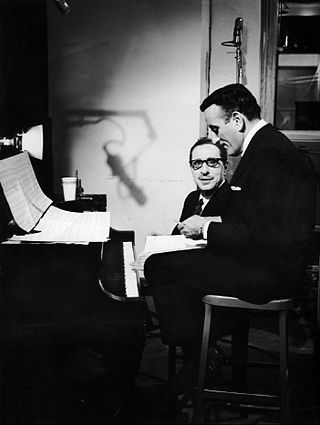
The Twentieth Century was a documentary television program that ran on the CBS network from 1957 until 1966. The series produced 112 historical compilation films and 107 "originally photographed documentaries" or contemporary documentaries, each running a half-hour. Productions were narrated by Walter Cronkite and drew on the resources of CBS News. The compilations mixed newsreel footage and eyewitness interviews, focusing on great events, unfamiliar historical episodes, and biographical portraits, including contemporary figures in the arts, sciences, law, and politics. As the series progressed, the compilation films were gradually outnumbered by the contemporary documentaries, similar to the work being done in the CBS Reports series, but often treating social and political change overseas rather than in the U.S. Popular and critically-acclaimed, audiences averaged 13 million viewers a week, and the series was an influential forerunner to many subsequent television documentary series.

The Arthur Murray Party is an American television variety show that ran from July 1950 until September 1960. The show was hosted by dancers Arthur and Kathryn Murray, the show featured various acts and celebrity guests and acted as advertisement for their chain of dance studios. Each week, the couple performed a mystery dance, and the viewer who correctly identified the dance would receive two free lessons at a local studio.

The Seven Lively Arts is an American anthology series that aired on Sunday afternoons on CBS television from November 3, 1957, until February 16, 1958. The series was executive produced by John Houseman, and hosted by New York Herald Tribune critic John Crosby. Alfredo Antonini served as the musical director for several episodes. The title was taken from the influential book of the same name written by the cultural critic Gilbert Seldes, in which he argued that the low arts deserved as much critical attention as the high arts. The eleven programs produced were—not in order:
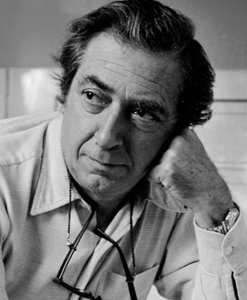
Norman Dello Joio was an American composer active for over half a century. He won a Pulitzer Prize in 1957.
Navy Log is an American television drama anthology series created by Samuel Gallu that presented stories from the history of the United States Navy. This series ran on CBS from September 20, 1955, until September 25, 1956. On October 17, 1956, it moved to ABC, where it aired until September 25, 1958. It changed networks because CBS "could not schedule it to the sponsor's wishes". The program aired for a total of three seasons and 104 episodes.
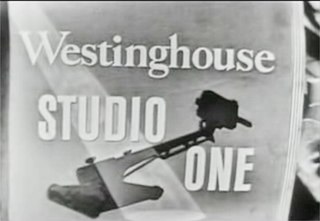
Studio One is an American anthology drama television series that was adapted from a radio series. It was created in 1947 by Canadian director Fletcher Markle, who came to CBS from the CBC. It premiered on November 7, 1948, and ended on September 29, 1958, with a total of 467 episodes over the course of 10 seasons.
The following is the 1957–58 network television schedule for the four major English language commercial broadcast networks in the United States. The schedule covers primetime hours from September 1957 through March 1958. The schedule is followed by a list per network of returning series, new series, and series cancelled after the 1956–57 season.
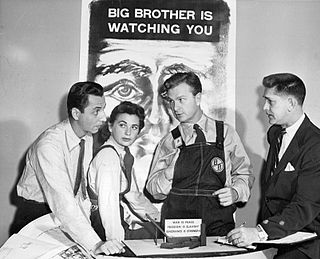
"1984" is an episode of the American television series Westinghouse Studio One broadcast September 21, 1953, on CBS. Starring Eddie Albert, Norma Crane and Lorne Greene, it was the first adaptation of George Orwell's 1949 novel Nineteen Eighty-Four.
Norman Scarth Macdonnell was an American producer for radio, television, and feature films. He is best known for co-creating with writer John Meston the Western series Gunsmoke, which was broadcast on CBS Radio from 1952 to 1961, and on television from 1955 to 1975.
The following is the 1956–57 network television schedule for the three major English language commercial broadcast networks in the United States. The schedule covers primetime hours from September 1956 through March 1957. The schedule is followed by a list per network of returning series, new series, and series cancelled after the 1955–56 season.
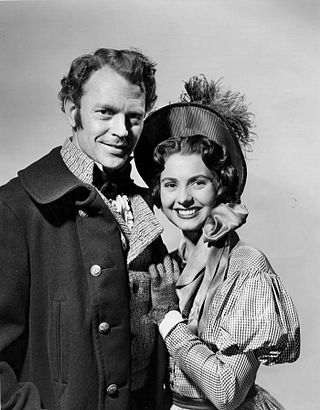
Schlitz Playhouse of Stars is an anthology series that was telecast from 1951 until 1959 on CBS. Offering both comedies and drama, the series was sponsored by the Joseph Schlitz Brewing Company. The title was shortened to Schlitz Playhouse beginning with the fall 1957 season.

Ford Theatre, spelled Ford Theater for the original radio version and known, in full, as The Ford Television Theatre for the TV version, is a radio and television anthology series broadcast in the United States in the 1940s and 1950s. At various times the television series appeared on all three major television networks, while the radio version was broadcast on two separate networks and on two separate coasts. Ford Theatre was named for its sponsor, the Ford Motor Company, which had an earlier success with its concert music series, The Ford Sunday Evening Hour (1934–42).
Alfredo Antonini was a leading Italian-American symphony conductor and composer who was active on the international concert stage as well as on the CBS radio and television networks from the 1930s through the early 1970s. In 1972 he received an Emmy Award for Outstanding Achievement in Religious Programming on television for his conducting of the premiere of Ezra Laderman's opera And David Wept for CBS television during 1971. In addition, he was awarded the Order of Merit of the Italian Republic in 1980
World War One is an American documentary television series that was shown on CBS during the 1964–1965 television season to commemorate the fiftieth anniversary of the start of the war.

The Triumph of St. Joan was originally an opera in three acts by Norman Dello Joio to an English language libretto on the subject of the martyrdom of Joan of Arc by Dello Joio and Joseph Machlis (1906–1998). It was premiered at Sarah Lawrence College on May 9, 1950. Although the opera was received positively, the composer was unhappy with the work and declined to have it performed again. However, he did adapt part of the opera into a symphony of the same title in 1951. The symphony was later renamed Seraphic Ode.
The Jane Froman Show was an American musical variety television series starring singer and actress Jane Froman that aired on CBS from 1952–1955.
The Vise is an American detective drama that was broadcast on ABC (1955–1957) and then moved to NBC (1957–1960). The series is a reboot of the ABC Mystery Theater radio and television series. It was produced by the Danzigers and starred Donald Gray as Mark Saber. It mostly ran during prime time in the late 1950s.

Hey, Jeannie!, retitled The Jeannie Carson Show during its second season and also during later prime-time reruns, is an American sitcom that aired on CBS during the 1956–57 television season and in first-run syndication during 1958. The series stars Jeannie Carson as a naïve young Scottish woman who emigrates to New York City.
My Friend Flicka is an American children's Western television series. The series is based on the novel of the same name by Mary O'Hara and the 1943 film My Friend Flicka by 20th Century Fox. It was one of the first television series produced by TCF Television Productions. Though filmed in color, it was originally shown on CBS in black-and-white from February 10, 1956 until May 18, 1958. Only one season was produced, but was broadcast in syndicated reruns for many years, starting in September 1957 on NBC.
Chester Watson was an American bass-baritone singer who had an active performance career in operas and concerts from the late 1940s into the 1970s. He was particularly active as a performer in opera on American television with the NBC Opera Theatre. He also made appearances with several American opera companies, including the New York City Opera, the Lyric Opera of Chicago, and the Opera Society of Washington. He is best known for creating roles in the world premieres of several American operas, including the First Police Agent in Gian Carlo Menotti's The Consul (1950), Father Julien in Norman Dello Joio's The Trial at Rouen (1956), Palivec in Robert Kurka's The Good Soldier Schweik (1958), and Leonard Swett in Thomas Pasatieri's The Trial of Mary Lincoln (1972). He notably starred opposite Maria Callas as Goffredo in the American Opera Society's lauded 1959 production of Vincenzo Bellini's Il pirata, which was recorded for EMI Classics. On the concert stage he appeared frequently with the National Symphony Orchestra during the 1950s, and also made guest appearances as a soloist with other American symphonies like the New York Philharmonic.










